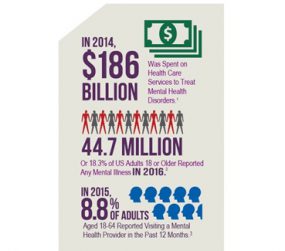Mental health disorders are among the most burdensome health concerns in the United States. Nearly 1 in 5 adults aged 18 or older (18.3% or 44.7 million people) reported any mental illness in 2016.2 In addition, 71% of adults reported at least one symptom of stress, such as a headache or feeling overwhelmed or anxious.
Many people with mental health disorders also need care for other physical health conditions, including heart disease, diabetes, respiratory illness, and disorders that affect muscles, bones, and joints. The costs for treating people with both mental health disorders and other physical conditions are 2 to 3 times higher than for those without co-occurring illnesses. By combining medical and behavioral health care services, the United States could save $37.6 billion to $67.8 billion a year.
About 63% of Americans are part of the US labor force. The workplace can be a key location for activities designed to improve well-being among adults. Workplace wellness programs can identify those at risk and connect them to treatment and put in place supports to help people reduce and manage stress. By addressing mental health issues in the workplace, employers can reduce health care costs for their businesses and employees.


Problem
Mental Health Issues Affect Businesses and Their Employees
Poor mental health and stress can negatively affect employee:
- Job performance and productivity.
- Engagement with one’s work.
- Communication with coworkers.
- Physical capability and daily functioning.
Mental illnesses such as depression are associated with higher rates of disability and unemployment.
- Depression interferes with a person’s ability to complete physical job tasks about 20% of the time and reduces cognitive performance about 35% of the time.11
- Only 57% of employees who report moderate depression and 40% of those who report severe depression receive treatment to control depression symptoms.12
Even after taking other health risks—like smoking and obesity—into account, employees at high risk of depression had the highest health care costs during the 3 years after an initial health risk assessment.13,14

Solution

Employers Can PROMOTE Awareness About the Importance of Mental Health and Stress Management
Workplace health promotion programs have proven to be successful, especially when they combine mental and physical health interventions.
The workplace is an optimal setting to create a culture of health because:
- Communication structures are already in place.
- Programs and policies come from one central team.
- Social support networks are available.
- Employers can offer incentives to reinforce healthy behaviors.
- Employers can use data to track progress and measure the effects.

Action steps employers can take include:
- Make mental health self-assessment tools available to all employees.
- Offer free or subsidized clinical screenings for depression from a qualified mental health professional, followed by directed feedback and clinical referral when appropriate.
- Offer health insurance with no or low out-of-pocket costs for depression medications and mental health counseling.
- Provide free or subsidized lifestyle coaching, counseling, or self-management programs.
- Distribute materials, such as brochures, fliers, and videos, to all employees about the signs and symptoms of poor mental health and opportunities for treatment.
- Host seminars or workshops that address depression and stress management techniques, like mindfulness, breathing exercises, and meditation, to help employees reduce anxiety and stress and improve focus and motivation.
- Create and maintain dedicated, quiet spaces for relaxation activities.
- Provide managers with training to help them recognize the signs and symptoms of stress and depression in team members and encourage them to seek help from qualified mental health professionals.
- Give employees opportunities to participate in decisions about issues that affect job stress.






